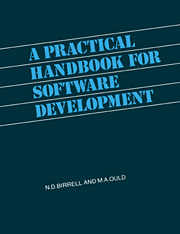Book contents
- Frontmatter
- Contents
- Foreword
- Preface
- 1 The choices facing the system developer
- 2 The software development process
- 3 Development techniques
- 4 Project Inception
- 5 System Definition
- 6 System Design
- 7 System Production
- 8 System Acceptance and Post-Acceptance Development
- 9 Project Debriefing
- Other bibliographies
- References
- Index
6 - System Design
Published online by Cambridge University Press: 11 January 2010
- Frontmatter
- Contents
- Foreword
- Preface
- 1 The choices facing the system developer
- 2 The software development process
- 3 Development techniques
- 4 Project Inception
- 5 System Definition
- 6 System Design
- 7 System Production
- 8 System Acceptance and Post-Acceptance Development
- 9 Project Debriefing
- Other bibliographies
- References
- Index
Summary
The purpose of the System Design Phase
Introduction
Although your main concern in the System Definition Phase will have been to decide what functions the system is to perform, you will also have given some thought as to how it is to perform them. During the System Design Phase you continue this process by deciding upon and documenting the overall strategy by which the system will perform the required functions. This involves mapping the system functions onto elements of software (and hardware) which can in the next phase be designed in detail and implemented.
The means by which this mapping is carried out can vary enormously, as can the designs resulting from different design approaches. The principal aim of the System Design Phase should, however, be the same no matter what design method is used; namely, to produce a system design which
is easily implemented,
and which, when implemented,
will provide all required functions,
will operate within any required constraints,
will be easily maintained.
Let us consider the implications of each of these goals for any potential system design methodology.
Ease of implementation
The process by which the system design will be implemented involves the following basic ingredients:
the system design (in the form of design documents),
the implementers (i.e. programmers etc.),
the virtual machine (i.e. the hardware and supporting systems software).
Information
- Type
- Chapter
- Information
- A Practical Handbook for Software Development , pp. 110 - 166Publisher: Cambridge University PressPrint publication year: 1985
